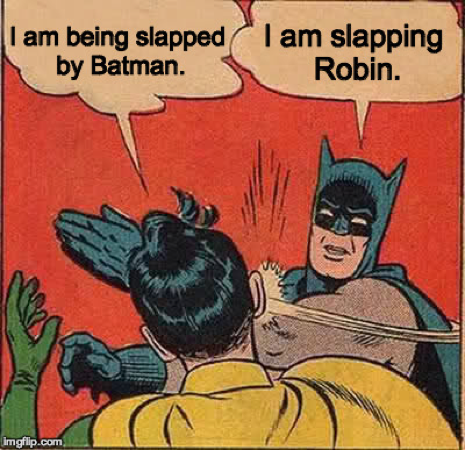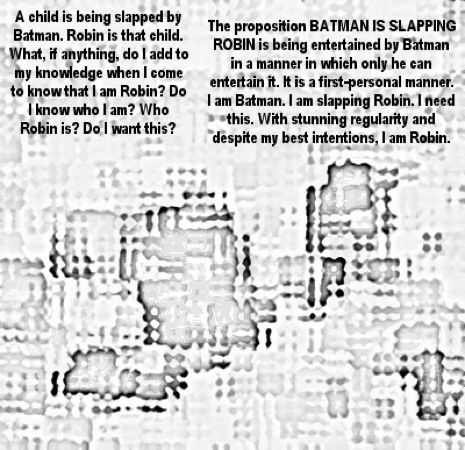One theme that suffuses my book-in-progress, A Certain Gesture: Evnine’s Batman Meme Project and Its Parerga!, a theme I have not written much about on this blog, is exile. I was moved to write something about it today when, by a series of fortuitous connections, it ran up against one of the memes from my book.

(The book’s commentary on the meme, however, deals with quite different issues.) I was reading a review, by Nathan Goldman, of Joshua Cohen’s recent novel The Netanyahus. The novel is a fictionalized account of the coming to America of the Israeli historian Ben-Zion Netanyahu, along with his family, including his son Benjamin, future prime minister of Israel.
In the novel, the elder Netanyahu is asked to teach a class on the Bible as part of the hiring process. In the course of this class, he says:
Zion, because it was remembered not as written history but as interpretable story, was able to exist again in actuality, with the founding of the modern state of Israel. With the establishment of Israel, the poetic was returned to the practical . . . Now that Israel exists, however, the days of the Bible tales are finished and the true history of my people can finally begin.
In life, Ben-Zion Netanyahu had worked as an assistant for the Zionist Revisionist leader Ze’ev Jabotinsky and Goldman, the reviewer, quotes Jabotinsky as having said, during a speech in 1938:
Eliminate the Diaspora or the Diaspora will eliminate you.
1938. It would have been then, or perhaps a year or two earlier, that my father heard Jabotinsky speak in London. (Jabotinsky lived in London from 1936 until his death in 1940.) That encounter left an indelible mark on my father who from then on remained a faithful adherent of Jabotinsky’s brand of Zionism. Perhaps he heard that very sentence from Jabotinsky’s own mouth. It certainly expresses a sentiment my father fervently shared. It was this sentiment that I had to work so hard to free myself from, separating myself from the tents of my father and striking forth into the wilderness, into a kind of exile. (This was happening right around the time my parents picked up and moved, finally, to Israel, leaving me, aged 18, effectively an orphan in London.)
I particularly like Cohen’s imagining of Netanyahu’s words because it so readily offers me the language for my own view. For Netanyahu, the “days of Bibles tales” extend all the way up to the founding of the state of Israel. It is only with this event that the history of the Jews begins. My own, more melancholy, take on the founding of Israel is that it marks the end of the history, if not of the Jews, at least of Judaism. It is the point at which a large segment of Jewry turned its back on the particular ‘genius’ of Judaism and plunged bloodily and enthusiastically into being a nation like any other.
The ‘genius’ of Judaism, of course, is exile. The Bible (and here I agree with Netanyahu) does not detail the early history of the Jews. It is a pre-historic myth, an origin story, needed to establish the basis for the real beginning of Jewish history – the exile of 70CE. It is not the Bible that is the book of which Jews are the people, it is the Talmud. The Talmud itself, by a clever trick, manages even to be in exile from itself. It exists in two versions, the Jerusalem (or Palestinian) Talmud and the Babylonian Talmud. The latter, naturally, eclipses the former in prominence. Since that time, the Jews have embodied unrootedness. Unrootedness is something that anti-Semites have used to foster hatred and suspicion of them. I think a similar accusation lies barely concealed beneath the surface of Ben-Zion Netanyahu’s words – words not at all uncommon in Zionist circles.
Life in exile is a terrible burden and a precious gift. Though it has brought me suffering I would not give it up for the world. (I hope my book will express something of how exile has characterized my life.) I spoke in an earlier post of being, as a Jew, for the letter. I can’t yet explain precisely how but this seems, in my own mind, to be the same as being for exile.
In the book’s commentary on the meme above, I discuss many things, among which is the influence of Poe on the Portuguese poet Fernando Pessoa. (You will get an inkling of why if I tell you my main source is a paper by the Pessoa scholar George Monteiro entitled “The Bat and the Raven.”) Pessoa translated Poe’s poem into Portuguese. One of the elements of Jabotinsky’s hagiography that I grew up with was his having translated “The Raven” into Hebrew. In fact, he translated it into both Hebrew and Russian. (He was a gifted linguist.) You can see the MS, in which he used Latin characters (I don’t know why) here. It was in my pre-exilic years, in the bosom of my family, that I first learned “The Raven” from my father.











